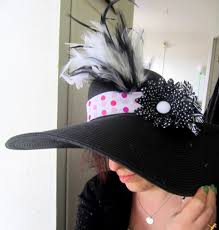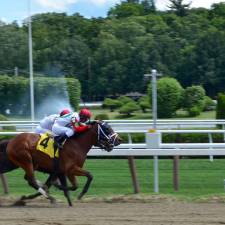
When you think of the Kentucky Derby you think of two things: big horses and big hats. Women’s hats. There are plenty of other big racing days, but none of them in the United States are associated with the millinery grandeur the same way as this longest consecutively running sporting event on the first Saturday in May and began in 1872. The first editorial mention of hats at the Derby was in a 1926 edition of Time Magazine. It wasn't much of a mention, and was stuck in the middle of an extremely long, convoluted sentence describing the start of the race. “… hats and parasols and a foam of faces…”
For those of you who are new to the sport, the Kentucky Oaks is run the day before the Derby. Unless otherwise stated, most other races including the Kentucky Derby are open to both genders. Although, the general public is probably not as familiar with it, it too is a “hat” affair.
The Kentucky Oaks and Kentucky Derby were founded at the same time by Colonel Meriwether Lewis Clark Jr. in 1875. Thoroughbred racing, which started in Europe, set the trend as a fashionable event across the pond, and those attending adhered to the trendy styles of the day. However, it has been a bit of a rollercoaster ride in America: in the beginning stages of American racing, women had a tendency to think the racetrack may not be the proper place for a lady. Meriwether, with the help of his wife, decided that they should present the experience as a picnic outing, which would require what is called “full morning dress” for both men and women. For women it was not overly formal, but respectively presentable. For men, it was job attire. Hats were more in the style of simple bonnets to keep the sun off women’s delicate white skin, as tanned skin was considered to be a lower class attribute, for those who worked in the fields.

Meriwether had been influenced by the elegant and wealthy racing atmosphere abroad. Those stylish European patrons of the English Epson Derby and the French Grand Prix, were the upper crust of society. This became Meriwether’s goal, to attract patrons of this echelon for the Kentucky Derby and the Kentucky Oaks. He intended to transform the reputation—that racetracks were places of ill-repute—to track being seen as worthy of the mantle, “The Sport of Kings and Queens.”

Meriwether’s vision came to fruition, and the Kentucky Derby and Oaks became the place to be for high society and high fashion. It was no longer a place for morning dress: horse racing’s elite embraced the transition to formal dress. Hats became more colorful, wider-brimmed and accented with fanciful feathers.
Dress in the 1920s – 1930s in America became took a turn following World War I, as women showed their first real sign of modern independence. They had been part of the work force during the war, and did not want to give that up. They liked earning their own money. And they liked dressing the way they wanted to—not what was expected of them. Coco Chanel saw this new-found independence, and encouraged it as she had tremendous influence, as she presented dresses that rejected the restrictions of Victoriana. Chanel designed that which we now call, “flapper” dresses: shapeless, comfortable and a new kind of chic and sexy. Women wanted to remain fashionable, but they wanted equality with men—and Chanel’s flapper look filled that need, and influenced other designers.

This new dress style may have seemed to be “boyish,” but were anything but: loose-fitting, yet usually low cut in the back. The skirts were considered short, hitting just below the knee and sometimes above the knee for a night out dancing the Charleston, a dance that contained of a lot of leg movement. Skirted suits may have been seen as being masculine, all straight lines. Ruffles were definitely out. They bobbed their hair, and made it an afterthought with tight-fitting hats that covered most of their ears. These hats were called, “cloche,” and quickly became all the rage. Brims, if there were any, were small and folded toward the face.

There certainly has been a colorful metamorphosis, as hats also grew in size. As hats have grown exponentially over the decades, so has their “chic element.” To many, this shift from the simple cloche to enormous, ornate chapeaux is viewed as being a vast improvement. The two themes that carry on in almost all Derby hats are feathers and flowers. The Kentucky Derby always takes place on the first Saturday in May: a famous date with no numbers, designating the day that has been a tradition every year since its inception.
Historically, serious fashion trends have hailed from Paris and Rome. But America has come up with some original American trends, including style that not only includes springtime flowers and feathers, but also horses, jockeys, betting tickets, mint juleps and anything that has anything to do with the Derby or the Oaks. Many have left the realm of high fashion completely, and have crossed over into the Theater of the Absurd—but nonetheless, it’s lots of fun!
An equally important aspect that has grown is the size of the hats.
Last, but not least: what could be a more timeless, ageless, classic racing day look—than Audrey Hepburn at the races in My Fair Lady, when she turned class on its head with iconic line, “Come on, Dover. Move your bloomin’ arse”? Answer – nothing. Eliza Doolittle was all Ascot, and Hepburn was America’s Mona Lisa, only prettier.













